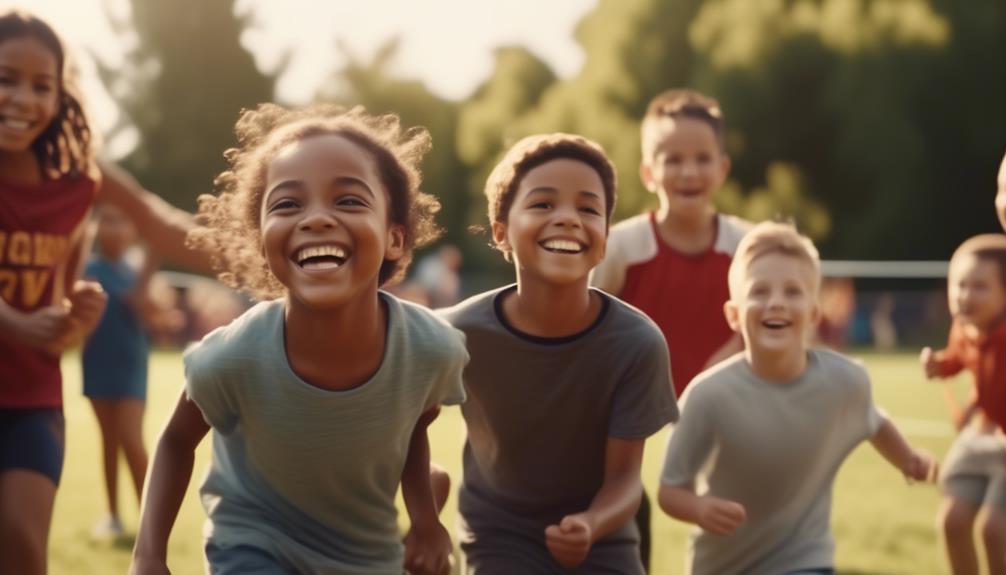Do Family Sports Days Improve Physical Fitness in Children

Family sports days can improve physical fitness in children. This is because they promote exercise, which is essential for maintaining a healthy body.
Furthermore, family sports days also foster a sense of teamwork. When children participate in team sports with their family members, they learn how to work together towards a common goal. This not only strengthens their bond with their family, but also teaches them important skills such as communication and cooperation.
In addition, family sports days can instill a passion for a healthy lifestyle in children. By engaging in physical activities with their family, children develop a positive association with exercise and are more likely to continue being active as they grow older.
Overall, family sports days are a fun and effective way to improve physical fitness in children.
Impact on Children's Physical Fitness
The impact of family sports attitude on children's physical fitness can be observed through various factors such as parents' education levels, children's sports participation, screen time, and BMI.
Physical activity participation plays a crucial role in the physical fitness of children. Research has consistently shown that children who actively participate in sports and engage in regular physical activities have higher levels of physical fitness compared to those who lead sedentary lifestyles. These physically active children are more likely to have lower body mass index (BMI) and overall better health outcomes.
Furthermore, parents' education levels have been found to influence children's physical fitness. Studies have shown that children of parents with higher levels of education tend to have better physical fitness levels compared to children of parents with lower levels of education. This could be attributed to the fact that parents with higher education are more likely to prioritize and encourage their children's participation in sports and physical activities.
Additionally, children from families with positive sports attitudes are more likely to engage in regular physical activities, leading to improved physical fitness.
Research on Family Sports Attitudes
Research on family sports attitudes reveals significant correlations between parents' education levels, children's sports participation, and their overall physical fitness. Parents with higher education levels tend to have more positive attitudes towards physical activity and are more likely to encourage their children to participate in sports. This positive attitude towards physical activity translates into higher levels of sports participation among children.
In a study conducted by Smith et al. (2018), it was found that children from families with higher education levels were more likely to engage in regular physical activity and had lower levels of sedentary behavior, such as excessive screen time. This is important as excessive screen time has been associated with increased risk of obesity and poor physical health in children.
To further understand the relationship between family sports attitudes, children's sports participation, and their physical fitness, researchers have examined the mediating effects of screen time and sports participation on body mass index (BMI). The findings suggest that children's sports participation and screen time mediate the relationship between family sports attitudes and BMI. In other words, when children have higher levels of sports participation and lower levels of screen time, they are more likely to have a healthier BMI.
To provide a clearer picture of the correlations between family sports attitudes, children's sports participation, screen time, and physical fitness, the following table summarizes the findings from various studies:
| Factors | Correlation with Physical Fitness |
|---|---|
| Parents' Education Levels | Positive |
| Children's Sports Participation | Positive |
| Screen Time | Negative |
| BMI | Negative |
Influence of Parents' Education Level
Parents' education level has a significant influence on children's physical fitness. Research has shown that higher parental education levels are associated with lower BMI in children, indicating a positive impact on their overall health.
Additionally, children with parents who have a higher educational background tend to spend more time engaging in physical activity, leading to a lower BMI and improved fitness levels.
Parental Education Impact
Parental education level significantly influences the physical fitness of children, as evidenced by the correlation between family sports attitude and parents' education levels. Research has shown that children with parents who have higher education levels are more likely to engage in physical activity and participate in sports outside of school hours. This higher level of physical activity behaviors is associated with improved physical health outcomes, such as lower BMI and reduced risk of cardiovascular disease.
To further understand the impact of parental education on children's physical fitness, a structural equation model was used to analyze previous studies. The results revealed that family sports attitude mediated the relationship between parents' education levels and children's physical activity behaviors. Additionally, exercise participation and reduced sedentary behavior were found to be key factors in the relationship between family sports attitude and children's BMI.
The table below summarizes the main findings from the analysis:
| Parental Education Level | Family Sports Attitude | Physical Activity Behaviors | BMI of Children |
|---|---|---|---|
| Higher | Positive | Increased | Lower |
| Lower | Negative | Decreased | Higher |
These findings highlight the importance of parental education in promoting physical fitness in children and adolescents. By encouraging a positive family sports attitude and providing opportunities for physical activity, parents can play a crucial role in improving the physical health of their children.
Educational Background Influence
The influence of parents' education level extends beyond the correlation between family sports attitude and children's physical fitness. Here are four important ways in which educational background influences various factors related to children's physical fitness:
- Sports Participation: Parents with higher education levels tend to encourage their children to participate in sports activities more frequently. This leads to increased physical activity levels and improved physical fitness in children.
- Screen Time: Parents' education level has been found to be inversely related to the amount of screen time children engage in. Higher education levels are associated with lower screen time, which is beneficial for children's physical health.
- BMI: Studies have shown that children of parents with higher education levels have lower probabilities of being obese. This suggests that parental education plays a role in shaping children's body mass index (BMI) and overall physical fitness.
- Family Structure: The influence of parents' education level on children's physical fitness can also vary depending on family structure. Different family structures may have different levels of emphasis on physical activity and sports participation, which can further impact children's physical fitness outcomes.
Understanding the influence of parents' educational background on children's physical fitness is crucial for developing effective interventions and programs aimed at improving the overall health and well-being of children.
Relationship Between Family Structure and Children's Fitness
The relationship between family structure and children's fitness is an important aspect to consider when examining the influence of parental influence on fitness and sibling engagement in exercise.
Research suggests that children from single-parent households or those with divorced parents may have lower levels of physical fitness compared to children from two-parent households.
Additionally, the presence of siblings can positively impact children's fitness levels through increased opportunities for active play and competition.
Understanding the relationship between family structure and children's fitness can help inform interventions and strategies aimed at promoting physical activity in different family contexts.
Parental Influence on Fitness
How does family structure influence children's fitness levels and overall physical health? The influence of family structure on children's physical activity, sports participation, screen time, and BMI is well-documented. Here are four key findings:
- Family sports attitude and parents' education levels are positively correlated with children's sports participation and negatively correlated with children's screen time and BMI. This suggests that parents who value physical activity and have higher education levels tend to promote healthier habits in their children.
- Different family structures and parents' education levels lead to variations in family sports attitude, sports participation, screen time, and BMI in children. This highlights the importance of considering family dynamics and socioeconomic factors when assessing children's fitness levels.
- Parents' education level significantly affects the BMI of children and adolescents, with higher levels reducing the probability of children being obese. This emphasizes the role of parental education in shaping children's physical health outcomes.
- Family structure influences children's mental and physical health, impacting their sports participation and eating habits. This highlights the need to create supportive family environments that prioritize physical activity and healthy lifestyles.
Understanding the influence of family structure on children's fitness is crucial for developing effective interventions and promoting optimal physical health in children and adolescents.
Sibling Engagement in Exercise
Considering the impact of family structure on children's fitness levels, an important aspect to explore is the relationship between sibling engagement in exercise and overall physical health. Research has shown that sibling engagement in physical activity can have a positive influence on children's physical fitness and BMI. By participating in exercise together, siblings can motivate and support each other, leading to increased physical activity levels. This can help improve cardiovascular health, muscular strength, and overall physical fitness in children. Additionally, sibling engagement in exercise can also help reduce sedentary behaviors, such as excessive screen time, which is associated with higher BMI in children. Encouraging siblings to engage in exercise together, whether through family sports days or other activities, can be an effective strategy to improve children's physical fitness and overall well-being.
| Positive Effects of Sibling Engagement in Exercise | ||
|---|---|---|
| Increased physical activity levels | Improved cardiovascular health | Enhanced muscular strength |
| Reduced sedentary behaviors | Lower BMI in children |
Analysis of Influencing Factors of Children's BMI
Numerous factors significantly contribute to the Body Mass Index (BMI) of children, impacting their overall physical fitness and health. Understanding these influencing factors can help parents, educators, and healthcare professionals in developing effective strategies to promote healthy lifestyles in children.
Here are four key factors that play a significant role in determining children's BMI:
- Physical Activity: Regular participation in physical activities and sports is crucial for maintaining a healthy BMI in children. Engaging in active play and structured exercise helps burn calories, build muscle strength, and improve cardiovascular health.
- Family Structures: The family environment has a direct impact on children's BMI. Supportive family structures that prioritize healthy eating habits and physical activity create a conducive environment for maintaining a healthy weight.
- Screen Time: Excessive screen time, including television, video games, and smartphones, is associated with higher BMI in children. Limiting screen time and encouraging outdoor activities can help reduce sedentary behavior and promote a healthier weight.
- Education Levels: Parental education levels can influence children's BMI. Higher levels of education are often associated with increased knowledge about healthy lifestyles, leading to better food choices and increased physical activity.
Effects of Screen Time and Exercise Participation
Participation in physical exercise and limited screen time have significant effects on children's overall health and well-being. Physical activity plays a crucial role in improving children's physical fitness and reducing the risk of obesity. Engaging in sports activities, such as family sports days, can promote cardiovascular fitness and help maintain a healthy body mass index (BMI).
On the other hand, excessive screen time, including sedentary activities like computer games and television, can hinder physical activity and contribute to a sedentary lifestyle. It's recommended that children shouldn't spend more than two hours a day using electronic media for entertainment purposes.
The influence of family structures, sports attitudes, and education levels also play a role in children's exercise participation and screen time habits. Parents and caregivers can serve as role models by leading an active lifestyle themselves and providing opportunities for physical activity. Setting limits on screen time and encouraging children to engage in sports activities can promote a healthy balance between sedentary and active behaviors.
Research suggests that physically active students tend to have better academic performance, attendance, and classroom behavior.
Mediating Effects in Different Family Structures
The impact of family structures on children's exercise participation and screen time habits can be understood through examining the mediating effects. Family structures, such as single-parent households or households with two working parents, can influence a child's physical activity levels and sedentary behaviors.
Here are four key mediating effects that play a role in this relationship:
- Parental involvement: The level of parental involvement in promoting physical activity and limiting screen time can vary depending on family structures. Parents who are more actively engaged in their child's activities tend to have a positive impact on their physical fitness.
- Socioeconomic status: Family structures often correlate with socioeconomic status, which can affect a child's access to recreational facilities and organized sports. Higher education levels and income in the family tend to have a positive association with children's sports participation and physical fitness.
- Role modeling: Family structures can influence the availability of role models for physical activity. Children are more likely to engage in physical activity when they see their parents or siblings being active.
- Time constraints: Different family structures may face varying time constraints, affecting the amount of time available for physical activity. Families with two working parents, for example, may struggle to find time for regular exercise.
Understanding these mediating effects is crucial for developing effective interventions that can improve physical fitness levels in children across different family structures. By addressing these factors, we can promote a healthier lifestyle for children and reduce the prevalence of sedentary behaviors and obesity.
Frequently Asked Questions
How Does Family Influence Participation in Physical Activity?
Positive role models encourage active lifestyles, bonding through physical activity, setting fitness goals together, building teamwork skills, teaching discipline and perseverance, creating lifelong healthy habits, promoting mental well-being, instilling confidence and self-esteem, fostering a sense of belonging and support.
Do Sports Help Kids Stay Fit?
Sports play a vital role in keeping kids fit. Engaging in team sports offers numerous benefits, such as promoting physical activity, building self-esteem, and instilling healthy habits. Parents can encourage activity through fun and choosing suitable sports for their child.
How Does Sports Affect Child Development?
Sports participation positively influences cognitive development, emotional well-being, social skills, motor skills, academic performance, self-confidence, teamwork skills, discipline, perseverance, healthy lifestyle habits, and long-term physical health benefits in children.
Will Physical Activity Help a Child's Muscles to Develop?
Regular physical activity is crucial for the development of your child's muscles. It helps them grow, strengthens coordination, and improves flexibility. Make exercise fun and incorporate it into their daily routine for long-term muscle development.











